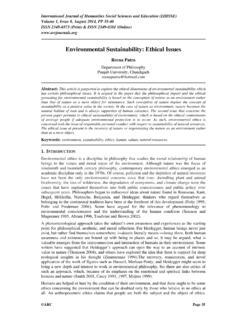Transcription of ELECTROMAGNETIC FIELDS AND PUBLIC HEALTH Effects …
1 International EMF Project Information Sheet February 2005 ELECTROMAGNETIC FIELDS AND PUBLIC HEALTH Effects of EMF on the environment Levels of ELECTROMAGNETIC FIELDS (EMF) from human-made sources have increased steadily over the past 50-100 years. Most EMF exposures come from increased use of electricity and new technologies. In the past decades, potential adverse Effects from EMF exposure on human HEALTH have been an important topic of research. However, little has been published about the impact of EMF on the natural terrestrial and aquatic environment .
2 The World HEALTH Organization (WHO) is addressing this issue through the International EMF Project. One of the Project s objectives is to provide advice to national authorities and others on EMF HEALTH and environmental Effects and protective measures or actions if needed. This information sheet summarizes the current scientific understanding on the Effects of exposure to EMF FIELDS on the living environment , across the ELECTROMAGNETIC spectrum in the frequency range 0-300 GHz. This range covers all frequencies that are emitted into the environment through use of EMF technology.
3 Recommendations are also given for further research to fill gaps in knowledge needed to better assess EMF environmental impacts. IS THERE REASON TO WORRY ABOUT ENVIRONMENTAL Effects OF EMF? Awareness of any environmental impacts of EMF is important to ensure the preservation of terrestrial and marine ecosystems, which form the basis for sustainable development. protection of the environment and conservation of nature have become matters of great interest to the PUBLIC , as well as to governments. Such interest is often expressed as concern over possible environmental impacts of large technology projects, such as dams, nuclear power plants, and radiofrequency transmitters.
4 Several projects have been subject to PUBLIC pressures on environmental grounds, with EMF being one but not necessarily the only issue. For example, a proposed high frequency (HF) radio transmitter for the Voice of America in Israel, which would have been the world s largest radio station, was blocked from construction on environmental grounds, in part related to concerns about potential Effects of radio frequency FIELDS on migrating birds. PUBLIC concern about environmental exposure to EMF has ranged from claims of reduced milk production in cows grazing under power lines to damage to trees near high power radars.
5 Such concerns might also affect the development of new technology: several plans have been proposed since the late 1960s for generating electric power in space by orbiting arrays of solar panels. Large amounts of electricity generated by such solar power satellites would be transmitted to sizeable antennas on the ground. In addition to overcoming technical difficulties, this and other new technologies would have to gain PUBLIC acceptance. Information sheet: Effects of EMF on the environment 1 SOURCES OF ENVIRONMENTAL EXPOSURE Emissions from natural as well as artificial sources make up the EMF environment we live in.
6 Natural sources, which include EMF radiation from the sun, the earth, the atmosphere including lightning discharges, account for only a small fraction of the overall EMF emissions in the 0-300 GHz frequency range. Human-made sources from major technologies have become an important component of the total EMF emissions into the environment . Relevant sources in the environment include: FM Radio and TV Transmitters: The strongest radio-frequency FIELDS in most urban areas are associated with radio and TV broadcast services (for more information, see Fact Sheet 183).
7 In urban areas, contributions from mobile phone base stations may reach similar amplitudes. Radar: Radar systems are used for a variety of tasks, ranging from navigation to aircraft and missile surveillance systems (for more information, see Fact Sheet 226). Wide-spread penetrations are expected from vehicle anti collision radar systems. High Voltage Power Lines: Power lines deliver electricity (usually at 50 or 60 Hz) and may span hundreds of kilometres (for more information related to their Effects on human HEALTH , see the WHO Fact Sheets 205, 263). Undersea Power Cables: Undersea cables are used in Europe (especially in Scandinavia and Greece), Canada, Japan, New Zealand and the Philippines to transfer electric power across water.
8 These sea cables usually conduct very large DC currents of up to a thousand amperes or more. For most of these sources, substantial EMF only exist adjacent to the source, where they may exceed international guidelines for limiting exposure of people (ICNIRP, 1998). These areas are generally not accessible to the PUBLIC but may be entered by fauna. Away from the EMF sources, the FIELDS decrease rapidly to intensities below ICNIRP s exposure guidelines. SUMMARY OF RELEVANT STUDIES Animals Most studies of EMF Effects in animals have been conducted to investigate possible adverse HEALTH Effects in humans.
9 These are usually performed on standard laboratory animals used in toxicological studies, rats and mice, but some studies have also included other species such as like short-living flies for the investigation of genotoxic Effects . The subject of this information sheet, however, is whether EMF can have harmful impacts on species of wild and domestic animals. Under consideration are: Species, in particular certain fish, reptiles, mammals and migratory birds, which rely on the natural (geomagnetic) static magnetic field as one of a number of parameters believed to be used for orientation and navigational cues Farm animals ( swine, sheep or cattle) grazing under power lines (50/60 Hz) or in the vicinity of broadcasting antennas Flying fauna, such as birds and insects, which may pass through the main beam of high power radio-frequency antennas and radar beams or through high intensity ELF FIELDS near power lines.
10 Studies performed to date have found little evidence of EMF Effects on fauna at levels below ICNIRP s guideline levels. In particular, there were no adverse Effects found on cattle grazing below power lines. However, it is known that flight performance of insects can be impaired in electric FIELDS above 1kV/m, but significant Effects have only been shown for bees when electrically conductive hives are placed directly under power lines. Un-insulated un-earthed conductors placed in an electric field can become charged and cause injury or disrupt the activity of animals, birds and insects.

















